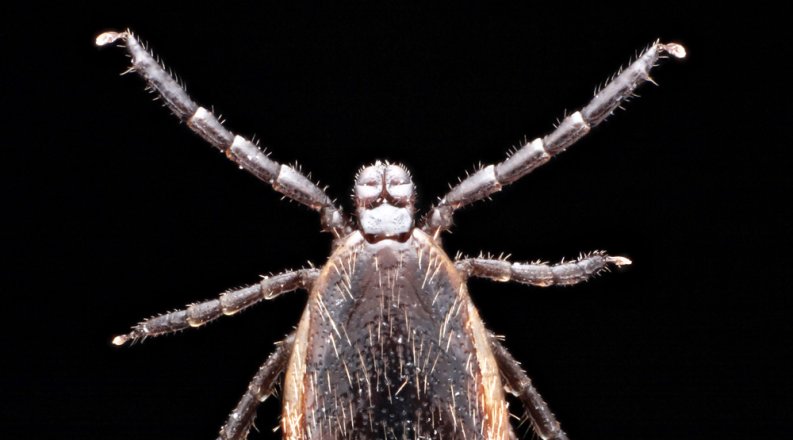As Hampton Roads residents head outside to enjoy the summer, they also have to think about any insects that may hitch a ride.
ODU News checked in with our resident tick expert, Holly Gaff, for tips on staying safe.
Gaff is a professor in the Biological Sciences Department at ODU who studies ticks and tick-borne diseases.
She shared some common myths about ticks, tips for staying safe and diagnosing tick-borne diseases and the impact climate change is having on tick populations.
ODU News: Does tick season ever truly end?
Holly Gaff: In Hampton Roads, I would argue that any time there aren't freezing temperatures we are in tick season. So, for us that is pretty much year-round. They don't die when it's cold, they just go into hibernation and wait till it warms up. I joke all the time that if we took some undergrads and laid them on the ground when it's cold, the ticks would warm right up. But I haven't had too many volunteers to test that theory.
Certainly, in the summer though, there are way more ticks. June is our peak month for collecting ticks, but the fall is when the lone star tick larvae - which is the most common in our area - come up in bunches and you can get "tick bombed" where hundreds of tiny ticks come out at once.
ODU News: What are the most common myths you hear about ticks?
Holly Gaff: The biggest one is that ticks fall from trees. People think they come from above because you'll often find them on your head, but the majority of ticks in the U.S. live on the ground and then crawl up your legs. Everyone shudders when I say that. Their whole job is to be stealth. They want to bite you so you can't feel it and stay there for a week, if they can, because they haven't eaten for a year.
The other myth is that you should find a way to get the tick to back out. Most commonly people try lighting a match near the tick or rubbing Vaseline on them. Honestly, you just want to take a pair of tweezers and pull straight up. I could give a lecture on all the amazing things ticks do to secure themselves to your skin, but the bottom line is they anchor themselves in and excrete cement. It's a little bit stronger than super glue, and they form a cement cone. They're not going to give up or back out.
ODU News: Which ticks cause Lyme disease, and are there other tick-borne diseases we should be aware of?
Holly Gaff: Lyme disease is the number one tick-borne pathogen in the U.S. The CDC estimates around 40,000-50,000 cases each year, which is probably low. It's more likely 400,000-500,000 because so many go unreported. While the lone star tick cannot transmit Lyme disease, it can cause a red meat allergy. We also have some black-legged - sometimes called deer ticks - which can cause Lyme disease. When you get over to Richmond you'll find a more aggressive version of that tick, but here in Hampton Roads we have sort of a lazy version.
ODU News: What tips should people follow to avoid ticks and what should they do if they find one on their body?
Holly Gaff: Most people who are diagnosed with tick-borne diseases - I would say 60% - don't remember having a tick on them. They're very tiny, very sneaky and they may be down by your ankle or the middle of your back where you can't see them. If you see a tick out in the woods, that one may not have attached to you, but its friend probably did.
The best way to avoid tick bites is to be aware when going outside. I highly recommend wearing light-colored clothes if you know you are going to be in tick territory. The ticks don't care, but you will have a better chance of seeing the tick crawling up your leg. I recommend using repellants such as DEET, picaridin and permethrin if you are comfortable with those (be sure to follow label instructions carefully). Long pants tucked into your socks might not be your idea of fashion, but it will give you a better chance of seeing the ticks before they bite.
Once you get home, you should immediately do a complete tick check. While ticks won't wash off in the shower, it is a great way to do a full body scan. Don't forget to check your pets as well. If you find one attached to your body, the key is to get it off as soon as you can. We advocate for people to keep the tick or take a picture of it. Each species of tick has a set of pathogens it can transmit and knowing which one it is can help your physician understand what you may have been exposed to.
When it comes to diagnosing Lyme disease, most people assume you'll have what is called a "bullseye rash." Not everyone develops this, though, and you often will not see it develop on persons of color, so it's important to look for the other symptoms like fatigue, a fever or a headache.
ODU News: How has climate change affected tick populations?
Holly Gaff: We're seeing an accelerated pattern of global extremism, and ticks are taking advantage of it. The lone star tick is now being found farther north in places like Maine, Michigan and Canada where they did not exist before. There is some evidence that suggests the southern edge may also be moving. There are some places in Texas and Florida that are seeing fewer of that species as the window of ideal climate moves northward. It's a very complex ecology that's moving them northward. It's not so much that they couldn't survive, but their hosts are moving as well.
ODU News: So, there are new communities dealing with a species of bug that they aren't used to?
Holly Gaff: Yeah, even when I got here to Old Dominion in late 2007, there was a survey of physicians who said they did not think Lyme disease was here yet, so it was difficult to educate the public.
Ticks are like weeds, and they're going to take advantage of any kind of disruption. In our area we have the Gulf Coast tick, which carries the spotted fever pathogen and really likes disturbed areas. One of the greatest disturbances in our area is hurricanes. So as hurricanes and major storms become more frequent, it creates an environment for the Gulf Coast tick to just explode.
ODU News: So, more hurricanes could lead to more ticks?
Holly Gaff: Yeah, it really speaks to the complexities of the systems we are disrupting, and the consequences that spill over into public health are really concerning.
ODU News: What about other bug species - are they being affected by climate change?
Holly Gaff: Yes. We've seen a few populations of fire ants move into our area. Some studies in southern states have shown that they are known to drive out ticks. Most people I talk to would prefer ticks, because they're slower to bite you. Fire ants, once they get you, it's very painful. You wouldn't wish them on your worst enemy. We're going to study them and see what happens since we have data from before their introduction to the area, which was missing from other studies.
ODU News: Do the fire ants eat the ticks, then?
Holly Gaff: We're hoping to test that. Some people say they do, others say they just drive the hosts out and the ticks starve.
ODU News: Ok, so you have a different relationship with ticks than most people. I don't think anyone likes ticks, but what do you like about researching ticks?
Holly Gaff: I certainly have gained a lot of respect and understanding for how they live and what systems they work in. We don't necessarily enjoy tick-borne diseases, and I'm not advocating for that in any way shape or form, but I think ticks certainly have a place in ecology. What we're seeing is a symptom of ecology being out of balance. If you are back in a better ecological balance, they're much less of a risk. We have removed so many of the predators that we don't want to live around and it's a very difficult thought to get back to that.
So, if I only ate once a year, which they do, I'd definitely be hungry and motivated. They also provide a food source for salamanders and birds and they're good at removing sick and weak animals. From a gene pool perspective, it helps keep other animals more evolutionarily streamlined. Humans cause more deaths than ticks do, so if we're here, then they can be here as well. The key is figuring out how to live in balance.






